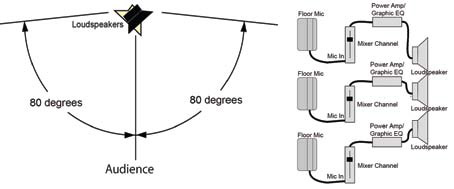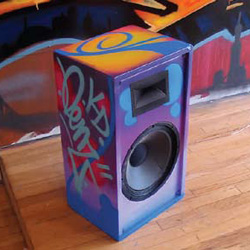Portable loudspeakers are amazing in their versatility, able to serve as mains, fills, delays, stage monitors and much more, providing solutions for hundreds of applications in live sound reinforcement.
These 2-way miracle workers usually include an 8-inch, 12-inch or 15-inch ported woofer and a compression driver on a horn or waveguide, with dispersion (6 dB-down points) commonly at 40 degrees (v) by 90 degrees (h) or 40 degrees (v) by 120 degrees (h).
The primary purpose of this dispersion is to focus sound on the audience while not sending it to reflective ceilings.
Coaxial designs, with the compression driver/horn suspended above the cone woofer, are also a popular option. Fans of coaxial loudspeakers like that high- and low-frequency sounds originate from the same point in space to provide more of a “point source” coherence. Coaxial models also typically take up less real estate.
Not all portable loudspeakers are created equal. Frequency response should be able to reproduce the sound source accurately, so for speech-only applications, a response of 100 Hz to 12 kHz is usually sufficient, while an acoustic guitar-singer will be better served by a response of 80 Hz to 15 kHz and a rock band should have a response of 40 Hz – 15 kHz (or higher).
These frequency limits are typically 10 dB down or less from the level at 1 kHz. Of course, the flatter the response over the passband, the more accurate is the reproduction.
Another choice is passive or active. Passive loudspeakers need to be driven by separate power amplification and might also require additional outboard processing, while active designs have the amplifier and processing built into the box.
Many active systems are also bi-amplified, with individual amplifiers for the woofer and compression driver. Bi-amplification can offer several advantages. Distortion frequencies caused by clipping the woofer’s amplifier will not reach the tweeter, so there is less likelihood of tweeter burn-out. In addition, clipping distortion in the woofer amplifier is made less audible.
Further, intermodulation distortion is reduced, peak power output is greater than that of a single amplifier of equivalent power, direct coupling of amplifiers to transducers improves transient response (especially at low frequencies), and the inductive and capacitive loading of the power amplifier is reduced. Finally, the full power of the tweeter amp is available regardless of the power required by the woofer amp.
On The Stick
When portable loudspeakers serve as mains, typically they’re deployed to either side of the stage on stands. This provides good overall coverage and also positions the loudspeakers toward the “dead” rear of the cardioid pattern of microphones, reducing the potential for feedback.
Also, they should be high enough to clear the crowd; otherwise, people in the back will hear muffled sound because the crowd attenuates the high frequencies.
Raising the loudspeakers also prevents sound from blasting the front rows of the audience. Articulation is best if the direct-sound level is high relative to the reflected-sound level. This is achieved by locating the loudspeakers close to the audience and aiming them to direct their sound on the audience, not on reflecting surfaces.
While placement is often done on an “eyeball” basis, sometimes a bit more preparation can make a big difference. Using graph paper or a computer, make a scale drawing of the venue. Inside this venue, draw the loudspeakers and their sound radiation angle, both in a top view and a side view.
Experiment with angling and placement so that the maximum amount sound is directed to the sound absorbing audience.

In some scenarios, when loudspeakers are placed on either side of the stage, audience members seated near the front row can be located too far from those loudspeakers, as well as too far off-axis. This problem is usually overcome by adding a fill loudspeaker (or a few) near the front edge of the stage in the center.
An alternative approach is to position two loudspeakers in a central location, then stack and splay them. This helps prevent the phase interference and comb filtering that can occur with spaced loudspeakers.















